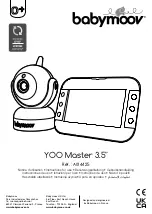
©2018 NEC Display Solutions, Ltd.
Page
14
of
71
3 Connections and Internal Operation
3.1 USB device connections to the Compute Module
The inputs USB CM1 and USB CM2 on the display are for connecting downstream USB devices, such as
a keyboard and mouse, additional storage, or a Wi-Fi adapter, to the Compute Module. The CM1 input is
capable of supplying higher powered devices with up to 2A of current. The CM2 input can supply 500 mA.
Power for the USB CM1 input can be configured via the display’s OSD to always be on, even when the
display is in standby mode, or to only supply power if the Compute Module is installed.
The input connection USB1 can be switched between the Compute Module, Internal PC (OPS), and an
external PC connected to the USB2 connection. It can be configured via the display’s OSD “PC SOURCE”
setting to switch automatically depending on the currently selected video input, or fixed to a specific
source. This allows devices such as a mouse or other input device to be shared automatically between
different sources.
For display models with an integrated touch-screen, the internal USB connection from the touch sensor
will also follow the “PC SOURCE” setting so that as video inputs on the display are changed, the touch-
screen connection will automatically switch to the correct source device.
Compute
Module
USB
Hub
Raspberry Pi
Compute Module
Interface Board
HDMI IN1
Internal PC (OPS)
ENABLE /
DISABLE
MONITOR CONTROL
Internal Touchscreen
connection (option)
Display USBControl
USB
Hub
PC SOURCE
AUTO
Shared between the Compute Module,
Internal PC (OPS), and External PC.
Controlled by the “PC SOURCE” setting
in “Control” -> “USB” on the OSD menu.
External PC input
Dedicated to the
Compute Module
Dedicated to the
Internal Media
Player
Figure 3.1-1: USB Device Connection















































